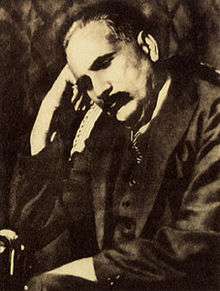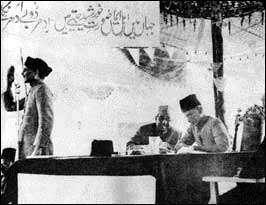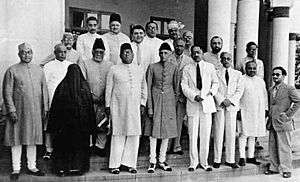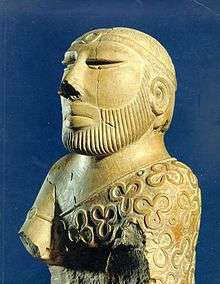History of the Islamic Republic of Pakistan
- This article is about the history of formation of Pakistan and as a country after 1947. For the history of ancient day Pakistan as a region, see History of Pakistan.
Part of a series on the |
||||||||||||||||||||
|---|---|---|---|---|---|---|---|---|---|---|---|---|---|---|---|---|---|---|---|---|
| History of modern Pakistan | ||||||||||||||||||||
| Pre-independence | ||||||||||||||||||||
|
||||||||||||||||||||
| Post-independence | ||||||||||||||||||||
|
||||||||||||||||||||
| See also | ||||||||||||||||||||
|
| ||||||||||||||||||||
The history of the modern day Islamic Republic of Pakistan mainly began since the Pakistan Movement, according to some sources from Two-Nation Theory, while Pakistan studies regards it to be starting from the arrival of Muhammad bin Qasim to Sindh. From 1947 until 1956, it was referred to as the Dominion of Pakistan. The country became an independent nation within the British Commonwealth on 14 August 1947. Muslim League leader Liaquat Ali Khan became the first Prime Minister of Pakistan.
Pakistan Movement
Early period of Pakistan Movement
In 1877, Syed Ameer Ali had formed the Central National Muhammadan Association to work towards the political advancement of the Indian Muslims, who had suffered grievously in 1857, in the aftermath of the failed Sepoy Mutiny against the East India Company; the British were seen as foreign invaders. But the organization declined towards the end of the 19th century.

In 1885, the Indian National Congress was founded as a forum, which later became a party, to promote a nationalist cause.[1] Although the Congress attempted to include the Muslim community in the struggle for independence from the British rule - and some Muslims were very active in the Congress - the majority of Muslim leaders did not trust the party, viewing it as a "Hindu-dominated" organization. Some Muslims felt that an independent united India would inevitably be "ruled by Hindus", and that there was a need to address the issue of the Muslim identity within India.
A turning point came in 1900, when the British administration in the United Provinces of Agra and Oudh acceded to Hindu demands and made Hindi, written in the Devanagari script, the official language. The proslytisation conducted in the region by the activists of a new Hindu reformist movement also stirred Muslim's concerns about their faith. Eventually, the Muslims feared that the Hindu majority would seek to suppress Muslim culture and religion in the region of an independent India.
The Muslim League
The All-India Muslim League was founded on 30 December 1906, in the aftermath of division of Bengal, on the sidelines of the annual All India Muhammadan Educational Conference in Shahbagh, Dhaka.[2] The meeting was attended by three thousand delegates and presided over by Nawab Viqar-ul-Mulk. It addressed the issue of safeguarding interests of Muslims and finalised a programme. A resolution, moved by Nawab Salimullah and seconded by Hakim Ajmal Khan. Nawab Viqar-ul-Mulk(conservative), declared:
The Musalmans are only a fifth in number as compared with the total population of the country, and it is manifest that if at any remote period the British government ceases to exist in India, then the rule of India would pass into the hands of that community which is nearly four times as large as ourselves ... our life, our property, our honour, and our faith will all be in great danger, when even now that a powerful British administration is protecting its subjects, we the Musalmans have to face most serious difficulties in safe-guarding our interests from the grasping hands of our neighbors.[3]
Pakistan was never founded as Islamic republic. The constitution and principles of the League were contained in the Green Book, written by Maulana Mohammad Ali. Its goals at this stage did not include establishing an independent Muslim state, but rather concentrated on protecting Muslim liberties and rights, promoting understanding between the Muslim community and other Indians, educating the Muslim and Indian community at large on the actions of the government, and discouraging violence. However, several factors over the next thirty years, including sectarian violence, led to a re-evaluation of the League's aims.[4][5] Among those Muslims in the Congress who did not initially join the League was Jinnah, a prominent statesman and barrister in Bombay. This was because the first article of the League's platform was "To promote among the Mussalmans (Muslims) of India, feelings of loyalty to the British Government".
In 1907, a vocal group of Hindu hard-liners within the Indian National Congress movement separated from it and started to pursue a pro-Hindu movement openly. This group was spearheaded by the famous trio of Lal-Bal-Pal - Lala Lajpat Rai, Bal Gangadhar Tilak and Bipin Chandra Pal of Punjab, Bombay and Bengal provinces respectively. Their influence spread rapidly among other like minded Hindus - they called it Hindu nationalism - and it became a cause of serious concern for Muslims. However, Jinnah did not join the League until 1913, when the party changed its platform to one of Indian independence, as a reaction against the British decision to reverse the 1905 Partition of Bengal, which the League regarded it as a betrayal of the Bengali Muslims.[6] After vociferous protests of the Hindu population and violence engineered by secret groups, such as Anushilan Samiti and its offshoot Jugantar of Aurobindo and his brother etc., the British had decided to reunite Bengal again. Till this stage, Jinnah believed in Mutual co-operation to achieve an independent, united 'India', although he argued that Muslims should be guaranteed one-third of the seats in any Indian Parliament.

The League gradually became the leading representative body of Indian Muslims. Jinnah became its president in 1916, and negotiated the Lucknow Pact with the Congress leader, Bal Gangadhar Tilak, by which Congress conceded the principle of separate electorates and weighted representation for the Muslim community.[7] However, Jinnah broke with the Congress in 1920 when the Congress leader, Mohandas Gandhi, launched a law violating Non-Cooperation Movement against the British, which a temperamentally law-abiding barrister Jinnah disapproved of. Jinnah also became convinced that the Congress would renounce its support for separate electorates for Muslims, which indeed it did in 1928. In 1927, the British proposed a constitution for India as recommended by the Simon Commission, but they failed to reconcile all parties. The British then turned the matter over to the League and the Congress, and in 1928 an All-Parties Congress was convened in Delhi. The attempt failed, but two more conferences were held, and at the Bombay conference in May, it was agreed that a small committee should work on the constitution. The prominent Congress leader Motilal Nehru headed the committee, which included two Muslims, Syed Ali Imam and Shoaib Quereshi; Motilal's son, Pt Jawaharlal Nehru, was its secretary. The League, however, rejected the committee's report, the so-called Nehru Report, arguing that its proposals gave too little representation (one quarter) to Muslims – the League had demanded at least one-third representation in the legislature. Jinnah announced a "parting of the ways" after reading the report, and relations between the Congress and the League began to sour.
Muslim homeland - "Now or Never"

The general elections held in the United Kingdom had already weakened the leftist Labour Party led by Prime Minister Ramsay MacDonald.[8] Furthermore, the Labour Party's government was already weakened by the outcomes of the World War I, which fueled new hopes for progress towards self-government in British India.[8] In fact, Mohandas K. Gandhi traveled to London to press the idea of "self-government" in British India, and claimed to represent all Indians whilst duly criticized the Muslim League as being sectarian and divisive.[8] After reviewing the report of the Simon Commission, the Indian Congress initiated a massive civil disobedience movement under Gandhi; the Muslim League reserved their opinion on the Simon Report declaring that the report was not final and the matters should decided after consultations with the leaders representing all communities in India.[8]
As the leaders of the Indian Congress were jailed and restrained, the Round-table conference was held, but these achieved little, since Gandhi and the League were unable to reach a compromise.[8] Witnessing the events in the Round-table conference, Jinnah had despaired of politics and particularly of getting mainstream parties like the Congress to be sensitive to minority priorities. During this time in 1930, notable writer and poet, Muhammad Iqbal called for a separate and autonomous nation-state, who in his presidential address to the 1930 convention of the Muslim League said that he felt that a separate Muslim state was essential in an otherwise Hindu-dominated South Asia.[9][10]
The name of the nation-state was coined by the Cambridge University's political science student and Muslim nationalist Rahmat Ali,[11] and was published on 28 January 1933 in the pamphlet Now or Never.[12] After coining the name of the nation-state, Ali noticed that there is an acronym formed from the names of the "homelands" of Muslims in northwest India:
An "i" was later added to the English rendition of the name to ease pronunciation, producing "Pakistan", by Ali. In Urdu and Persian languages, the name encapsulates the concept of Pak ("pure") and stan ("land") and hence a "Pure Land".[13] In the 1935, the British government proposed to hand over substantial power to elected Indian provincial legislatures, with elections to be held in 1937.[14] After the elections the League took office in Bengal and Punjab, but the Congress won office in most of the other provinces, and refused to devolve power with the League in provinces with large Muslim minorities citing technical difficulties.
Meanwhile, Muslim ideologues for independence also felt vindicated by the presidential address of V.D. Savarkar at the 19th session of the famous Hindu nationalist party Hindu Mahasabha in 1937. In it, this legendary revolutionary - popularly called Veer Savarkar and known as the iconic father of the Hindu fundamentalist ideology - propounded the seminal ideas of his Two Nation Theory or ethnic exclusivism, which influenced Jinnah profoundly.
In 1940, Jinnah called a general session of the Muslim League in Lahore to discuss the situation that had arisen due to the outbreak of the World War II and the Government of India joining the war without consulting Indian leaders. The meeting was also aimed at analyzing the reasons that led to the defeat of the Muslim League in the general election of 1937 in the Muslim majority provinces. In his speech, Jinnah criticized the Indian Congress and the nationalists, and espoused the Two-Nation Theory and the reasons for the demand for separate homelands.[15] Sikandar Hayat Khan, the Chief Minister of Punjab, drafted the original resolution, but disavowed the final version,[16] that had emerged after protracted redrafting by the Subject Committee of the Muslim League. The final text unambiguously rejected the concept of a United India because of increasing inter-religious violence[17] and recommended the creation of independent states.[18] The resolution was moved in the general session by Shere-Bangla Bengali nationalist, AKF Haq, the Chief Minister of Bengal, supported by Chaudhry Khaliquzzaman and other leaders and was adopted on 23 March 1940.[19] The Resolution read as follows:
No constitutional plan would be workable or acceptable to the Muslims unless geographical contiguous units are demarcated into regions which should be so constituted with such territorial readjustments as may be necessary. That the areas in which the Muslims are numerically in majority as in the North-Western and Eastern zones of India should be grouped to constitute independent states in which the constituent units shall be autonomous and sovereign ... That adequate, effective and mandatory safeguards shall be specifically provided in the constitution for minorities in the units and in the regions for the protection of their religious, cultural, economic, political, administrative and other rights of the minorities, with their consultation. Arrangements thus should be made for the security of Muslims where they were in a minority.[20]

In 1941, it became part of the Muslim League's constitution.[21] However, in early 1941, Sikandar explained to the Punjab Assembly that he did not support the final version of the resolution.[22] The sudden death of Sikandar in 1942 paved the way over the next few years for Jinnah to emerge as the recognised leader of the Muslims of South Asia.[6] In 1943, the Sind Assembly passed a resolution demanding the establishment of a homeland.[23] Talks between Jinnah and Gandhi in 1944 in Bombay failed to achieve agreement and there were no more attempts to reach a single-state solution.
The French and British empires had been under tremendous political and military pressure during the World War II, and the speculations of disintegration of their colonial empires was rumored in all over the British India. In North-West Frontier Province, the British military had launched the military expeditions to quelled the armed rebellion. The 1945 UK general election saw the leftist Labour Party forming the government in Britain and many Indians were seeing independence within reach. But, Gandhi and Nehru were not receptive to Jinnah's proposal and were also adamantly opposed to dividing India, since they knew that the Hindus, who saw India as one indivisible entity, would never agree to such a thing.[6] In the Constituent Assembly elections of 1946, the League won 425 out of 496 seats reserved for Muslims (polling 89.2% of total votes) on a policy of creating an independent state of Pakistan, and with an implied threat of secession if this was not granted.[6]
By 1946, the British had neither the will, nor the financial resources or military power, to hold India any longer. Political deadlock ensued in the Constituent Assembly, and the British Prime Minister, Clement Attlee, sent a cabinet mission to India to mediate the situation. When the talks broke down, Attlee appointed Louis Mountbatten as India's last viceroy, to negotiate the independence of Pakistan and India and immediate British withdrawal.
Mountbatten, of imperial blood and a world war admiral, handled the problem as a campaign. Ignorant of the complex ground realities in British India, he brought forward the date of transfer of power and told Gandhi and Nehru that if they did not accept division there would be civil war in his opinion[6] and he would rather consider handing over power to individual provinces and the rulers of princely states. This forced the hands of Congress leaders and the "Independence of India Act 1947" provided for the two dominions of Pakistan and India to become independent on the 14 and 15 August 1947 respectively. This result was despite the calls for a third Osmanistan in the early 1940s.
Creation of Pakistan
On August 1947, the British Empire divided the British Indian Empire into two independent and sovereign countries, India and Pakistan. Immediately after the independence, both nations joined the British Commonwealth. The independence of India and Pakistan created the inter-religious violence of such magnitude that exchange of population along religious lines became a necessity in each country.
More than two million people migrated across the new borders and more than one hundred thousand died in the spate of communal violence, that spread even beyond these provinces. Major violence erupted following the division of Punjab, Bengal, and Kashmir which escalated into leading to the first war between India and Pakistan. With assistance and further United Nations (UN) and Soviet Union's involvement ended the war but it became a hitherto unresolved Kashmir dispute.
Following the independence, the Pakistan became involved in continuous territorial disputes with India (in east) over Kashmir and Bengal and with the Afghanistan (in west) over the tribal line. Its political history has been characterized by authoritarian military rule and the brief democratic competition between right-wing conservatives and left-wing parties throughout its history.
See also
References
- ↑ Chandra, Bipan; Amales Tripathi; Barun De (1972). Freedom struggle. New Delhi: National Book Trust, India.
- ↑ Jalal, Ayesha (1985). The sole spokesman : Jinnah, the Muslim League, and the demand for Pakistan. Cambridge (UK); New York: Cambridge University Press. ISBN 978-0-521-24462-6.
- ↑ "The Statesman: The All India Muslim League". Government of Pakistan. Retrieved 4 December 2007.
- ↑ Talbot, Ian (1999). Pakistan: a modern history. New Delhi; New York: Oxford University Press. ISBN 978-0-19-565073-0.
- ↑ Blood, Peter R. (1995). Pakistan: a country study. Washington, D.C.: Federal Research Division, Library of Congress. pp. 28–29. ISBN 978-0-8444-0834-7.
- 1 2 3 4 5 Kulke, Hermann; Dietmar Rothermund (1986). A History of India. Totowa, New Jersey: Barnes & Noble. pp. 300–312. ISBN 978-0-389-20670-5.
- ↑ Kulke, Hermann; Dietmar Rothermund (1986). A History of India. Totowa, New Jersey: Barnes & Noble. pp. 272–273. ISBN 978-0-389-20670-5.
- 1 2 3 4 5 "Round Table Conferences". Story of Pakistan. Round Table Conferences. Retrieved 27 September 2013.
- ↑ "Sir Muhammad Iqbal's 1930 Presidential Address". Speeches, Writings, and Statements of Iqbal. Retrieved 4 December 2007.
- ↑ Mir, Mustansir (2006). Iqbal. London; New York: I. B. Tauris. p. 138. ISBN 978-1-84511-094-9.
- ↑ Ihsan Aslam (11 February 2004). "The History Man: Cambridge remembers Rahmat Ali". Daily Times, Pakistan. Retrieved 4 December 2007.
- ↑ Choudhary Rahmat Ali (28 January 1933). "Now or never: Are we to live or perish for ever?". Pakistan Movement Historical Documents. Retrieved 4 December 2007.
- ↑ Brown, W. Norman (19 October 1946). "India's Pakistan Issue". Proceedings. American Philosophical Society. 91 (2): 161. ISBN 978-1-4223-8093-2. Retrieved 4 December 2007.
- ↑ "The Communal Award". The Communal Award. Retrieved 27 September 2013.
- ↑ Wolpert, Stanley A. (1984). Jinnah of Pakistan. New York: Oxford University Press. ISBN 978-0-19-503412-7.
- ↑ Tinker, Hugh (1987). Men who overturned empires : fighters, dreamers, and schemers. Madison: University of Wisconsin Press. p. 50. ISBN 978-0-299-11460-2.
- ↑ Malik, Muhammad Aslam (2001). The making of the Pakistan resolution. Karachi: Oxford University Press. ISBN 978-0-19-579538-7.
- ↑ Ahmed, Syed Iftikhar (1983). Essays on Pakistan. Lahore: Alpha Bravo Publishers.
- ↑ Qutubuddin Aziz. "Muslim's struggle for independent statehood". Jang Group of Newspapers. Retrieved 4 December 2007.
- ↑ Qureshi, Ishtiaq Husain (1967). A Short history of Pakistan. Karachi: University of Karachi.
- ↑ Qureshi, Ishtiaq Husain (1965). The struggle for Pakistan. Karachi: University of Karachi.
- ↑ Ahmad, Syed Nur; Mahmud Ali; Craig Baxter (1985). From martial law to martial law : politics in the Punjab, 1919–1958. Boulder, Colorado: Westview Press. p. 153. ISBN 978-0-86531-845-8.
- ↑ "Legislative Assembly of Sind under Government of India Act 1935.". Provincial Assembly of Sindh. Retrieved 4 December 2007.

